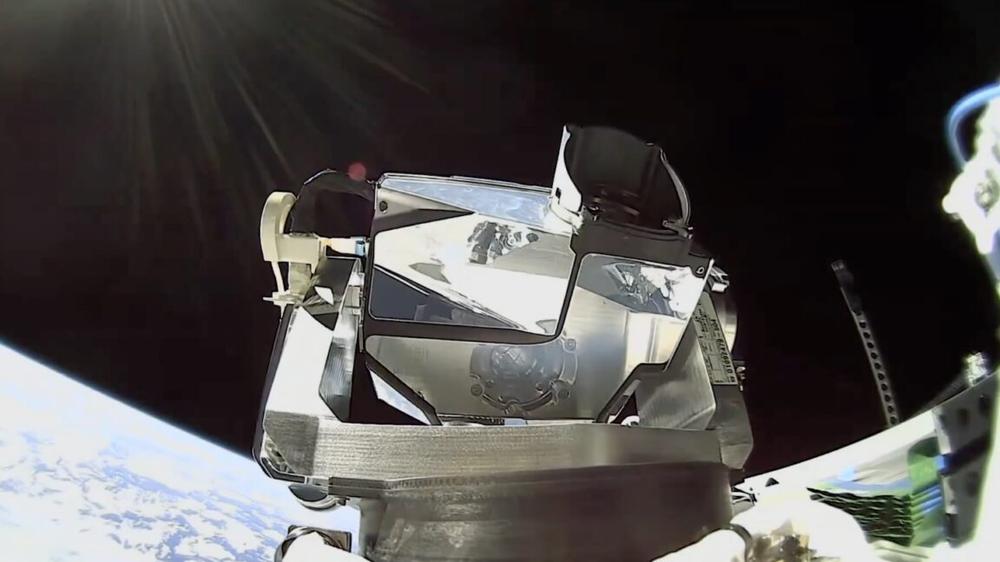A little over a year ago, one of SpaceX’s Crew Dragon spacecraft flew a team of four private astronauts to orbit on a mission that made history with the first fully commercial spacewalk.
Jared Isaacman and Sarah Gillis briefly floated out the door of the Dragon capsule, wearing SpaceX-built pressure suits to protect them against the hostile environment of space. It was the first time anyone ventured outside of their spacecraft without the involvement of a government space agency.
The mission, named Polaris Dawn, made an important contribution in another area. It was the first space mission to connect with SpaceX’s Starlink broadband network, using laser links between the Dragon spacecraft and Starlink satellites to communicate with the Earth.
Most satellites only have sporadic connectivity with their operators back on Earth. As satellites zip around the planet, they periodically pass over ground stations designed to receive data and transmit commands back up to the spacecraft. One exception is the International Space Station, which enjoys near-continuous communications through a fleet of NASA data relay satellites.
But those satellites are expensive. They exist only to serve government missions, like the ISS and the Hubble Space Telescope. The Starlink network, by contrast, connects with millions of users, whether they’re at home, on the road, at sea, or in the air.
One company, a California-based startup named Muon Space, is partnering with SpaceX to bring Starlink connectivity to low-Earth orbit. Muon announced Tuesday it will soon install Starlink terminals on its satellites, becoming the first commercial user, other than SpaceX itself, to use Starlink for in-flight connectivity in low-Earth orbit.
It’s all about the data
Muon was founded four years ago by a team of space industry veterans who sought to change the way satellites are built. While launch costs are coming down, satellite manufacturing remains an expensive business. Muon’s mission is to combine hardware, software, and operations expertise to design, build, and operate constellations of low-Earth orbit satellites on behalf of customers.
Essentially, Muon aims to become a one-stop shop for anyone with an idea and the money to use low-Earth orbit satellites for pretty much any purpose. The company has raised more than $180 million to date.
One of Muon’s first customers is FireSat, a program managed by a Google-backed nonprofit called Earth Fire Alliance to detect and track wildfires. The first FireSat demonstration satellite launched in March, and three more satellites are scheduled for launch next year, with the goal of fielding 50 satellites by 2030 to improve the fleet’s coverage.
FireSat’s thermal imagery has another potential application. The National Reconnaissance Office, the US government’s spy satellite agency, announced earlier this year it will buy FireSat data for its own use.
But no matter how good the satellites are, their effectiveness is only as good as the data they deliver to the people who need it. In some cases, it can take hours for a satellite to pass over a ground station, so the data is stale by the time it arrives on Earth.
“From the founding of the company, we were well-tuned to the fact that almost all of our customers are really ultimately interested in the data that they’re able to receive from their constellations,” said Pascal Stang, Muon’s co-founder and chief technology officer. “So, we invested in the company substantially in making sure that the data delivered was easy for them, that it was high volume for them.”
At first, Muon looked at ways to speed data delivery through ground stations and radio signals. Using lasers with Starlink is an “exciting evolution” of that approach, Stang said.
“High-speed, low-latency connectivity on orbit is foundational for modern space missions,” said Michael Nicolls, vice president of Starlink engineering at SpaceX. “By integrating Starlink mini-lasers, Muon’s spacecraft can remain persistently connected through our in-space laser mesh, enabling real-time tasking, continuous command-and-control, and immediate data delivery to terrestrial points of presence. We’re excited to support Muon Space as they bring these capabilities to commercial missions.”
Putting a single Starlink mini-laser terminal on a satellite would keep the spacecraft connected 70 to 80 percent of the time, according to Greg Smirin, Muon’s president. There would still be some downtime as the laser reconnects to different Starlink satellites, but Smirin said a pair of laser terminals would allow a satellite to reach 100 percent coverage.
So long, data limits
Lasers have other benefits over ground stations. Optical links offer significantly more throughput than traditional radio communication systems, and they’re not constrained by regulations on radio spectrum usage.
“What it does for our customers and for the company is we are able to get more than 10x, maybe even 50x, the amount of data that they’re able to bring down, and we’re able to offer them that on a latency of nearly instant,” Stang said in an interview with Ars.
SpaceX’s mini-lasers are designed to achieve link speeds of 25Gbps at distances up to 2,500 miles (4,000 kilometers). These speeds will “open new business models” for satellite operators who can now rely on the same “Internet speed and responsiveness as cloud providers and telecom networks on the ground,” Muon said in a statement.
Muon’s platform, called Halo, comes in different sizes, with satellites ranging up to a half-ton. “With persistent optical broadband, Muon Halo satellites will move from being isolated vehicles to becoming active, real‑time nodes on Starlink’s global network,” Stang said in a press release. “That shift transforms how missions are designed and how fast insights flow to decision‑makers on Earth.”
Muon said the first laser-equipped satellite will launch in early 2027 for an undisclosed customer.
“We like to believe part of why SpaceX trusts us to be the ones to be able to lead on this is because our system is designed to really deal with very different levels of requirements,” Smirin said. “As far as we’re aware, this is the first integration into a satellite. We have a ton of interest from commercial customers for our capabilities in general, and we expect this should just boost that quite significantly.”
FireSat is one of the missions where Starlink connectivity would have an impact by rapidly informing first responders of a wildfire, Smirin said. According to Muon, using satellite laser links would cut FireSat data latency from an average of 20 minutes to near real-time.
“It’s not just for the initial detection,” Smirin said. “It’s also once a fire is ongoing, [cutting] the time and the latency for seeing the intensity and direction of the fire, and being able to update that in near real-time. It has incredible value to incident commanders on the ground, because they’re trying to figure out a way to position their equipment and their people.”
Thinking big
Ubiquitous connectivity in space could eventually lead to new types of missions. “Now, you’ve got a data center in space,” Smirin said. “You can do AI there. You can connect with data centers on the ground.”
While this first agreement between Muon and SpaceX covers commercial data relay, it’s easy to imagine other applications, such as continuous live drone-like high-resolution streaming video from space for surveillance or weather monitoring. Live video from space has historically been limited to human spaceflight missions or rocket-mounted cameras that operate for a short time.
One example of that is the dazzling live video beamed back to Earth, through Starlink, from SpaceX’s Starship rockets. The laser terminals on Starship operate through the extreme heat of reentry, returning streaming video as plasma envelops the vehicle. This environment routinely causes radio blackouts for other spacecraft as they reenter the atmosphere. With optical links, that’s no longer a problem.
“This starts to enable a whole new category of capabilities, much the same way as when terrestrial computers went from dial-up to broadband,” Smirin said. “You knew what it could do, but we blew through bulletin boards very quickly to many different applications.”

 I spent a month living with a $430 AI pet, the Casio Moflin
I spent a month living with a $430 AI pet, the Casio Moflin